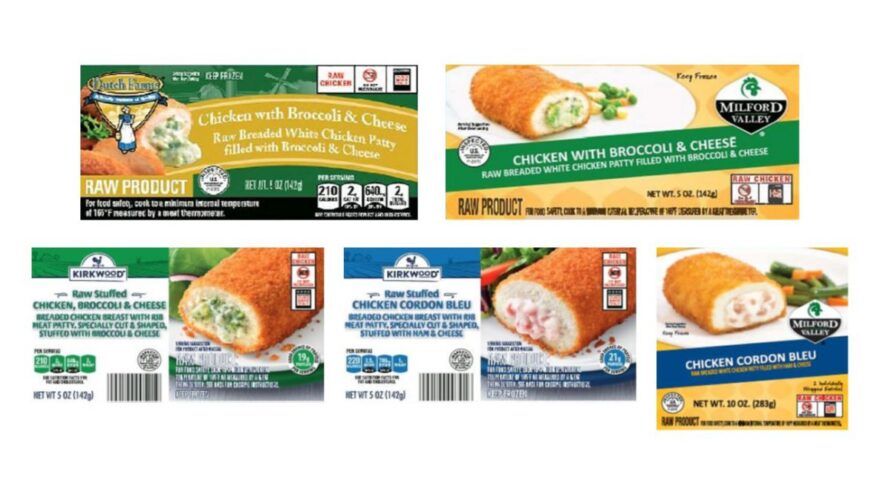Frozen stuffed breaded raw chicken products have repeatedly been implicated in Salmonella outbreaks (1). These products are partially cooked to set the breading, often making them appear cooked (2). Despite their appearance, these products need to be cooked to an internal temperature of 165°F (74°C) to ensure that they are safe to eat. Producers began implementing labeling changes in 2006 to more clearly identify these products as raw; many warn against using microwave ovens (microwaves) to prepare them and provide validated cooking instructions solely for conventional ovens (ovens) (3,4). However, outbreaks continued to occur after implementation of these labeling changes (4). To describe the demographic characteristics of persons who prepare frozen stuffed chicken products and which appliances they use to prepare them, data from a May–July 2022 representative panel survey were analyzed. Although most (82.7%) respondents used an oven as one of their cooking methods, more than one half (54.0%) of respondents also used another appliance, including 29.0% who used a microwave. Oven use was lower among respondents with household income <$25,000 (68.9%), and who lived in mobile homes or other portable types of homes (66.5%). Among respondents who reported using microwaves to cook these products, 8% reported using a microwave with ≤750 W of power, which might be insufficient to thoroughly cook such products (1,5,6). Economic and other factors might influence some groups’ access to recommended cooking appliances. Companies could consider implementing additional interventions that rely less on labeling and consumer preparation practices and focus on controlling or reducing levels of Salmonella in these products, such as selling them fully cooked, or monitoring and testing Salmonella levels, to ensure safety. These findings highlight challenges consumers might face in preparing frozen stuffed chicken products safely and can guide strategies for regulatory authorities and industry to prevent outbreaks and illnesses associated with them.

References
- Smith KE, Medus C, Meyer SD, et al. Outbreaks of salmonellosis in Minnesota (1998 through 2006) associated with frozen, microwaveable, breaded, stuffed chicken products. J Food Prot 2008;71:2153–60. https://doi.org/10.4315/0362-028X-71.10.2153PMID:18939771
- Sheryl C, Cates ES, Brophy J, et al. Food safety consumer research project: meal preparation experiment on raw stuffed chicken breasts. Washington, DC: U.S. Department of Agriculture, Food Safety and Inspection Service; 2020. https://www.fsis.usda.gov/sites/default/files/media_file/2021-04/fscrp-yr3-nrte-final-report.pdf
- Kremer S. Stuffed, not ready-to-eat poultry products. Washington, DC: U.S. Department of Agriculture; 2021. https://www.fsis.usda.gov/sites/default/files/media_file/2021-09/NACMPI-092021-pesentation-Stuffed-Not-Ready-to-Eat-Poultry-Products.pdf
- Food Safety and Inspection Service. Salmonella enteritidis outbreak linked to frozen, raw, breaded, stuffed chicken products outbreak investigation after action review, report 2021–07. Washington, DC: U.S. Department of Agriculture, Food Safety and Inspection Service; 2022. https://www.fsis.usda.gov/sites/default/files/media_file/2022-04/FSIS-After-Action-Review-2021-07.pdf
- Phebus R, Powell D, Thippareddi H. Beyond intent: assessment and validation of on-package handling and cooking instructions for uncooked, breaded meat and poultry products to promote consumer practices that reduce foodborne illness risks. Washington, DC: Foundation for Meat and Poultry Research and Education; 2009. http://meatpoultryfoundation.org/namif/wp-content/uploads/06-411.pdf
- Food Safety and Inspection Service. Information on validation of labeled cooking instructions for products containing raw or partially cooked poultry. Washington, DC: U.S. Department of Agriculture, Food Safety and Inspection Service; 2017. https://www.fsis.usda.gov/guidelines/2017-0017